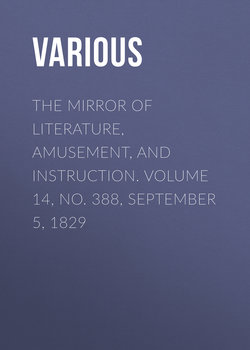The Mirror of Literature, Amusement, and Instruction. Volume 14, No. 388, September 5, 1829

Реклама. ООО «ЛитРес», ИНН: 7719571260.
Оглавление
Various. The Mirror of Literature, Amusement, and Instruction. Volume 14, No. 388, September 5, 1829
ST. DUNSTAN'S, FLEET STREET
A DESULTORY CHAPTER ON LOCALITIES
THE HUMBLE SPARROW'S ADDRESS TO T. S. A
TO A DESTRUCTIVE INSECT ON A ROSEBUD
THE CONTEMPORARY TRAVELLER
JOURNEY IN SEARCH OF THE RED INDIANS OF NEWFOUNDLAND
NOTES OF A READER
DERWENTWATER
MASANIELLO
LONDON
BURMESE DIGNITY
STEAM
MEDICAL MUSIC
SPIRIT OF THE PUBLIC JOURNALS
LINES ON THE DEPARTURE OF EMIGRANTS FOR NEW SOUTH WALES
SMALL TALK AND SMALL ACCOMPLISHMENTS, OR HOW TO MAKE YOURSELF AGREEABLE
THE SELECTOR; AND LITERARY NOTICES OF NEW WORKS
VIDOCQ
THE ANECDOTE GALLERY
RECOLLECTIONS OF PALEY
THE GATHERER
ERRORS OF THE PRESS
TESTAMENT OF A USURER
THE HINT TAKEN
Отрывок из книги
No church in London is perhaps better known than the above, which is distinctively called Saint Dunstan's in the West. External elegance has little to do with this celebrity, which has been acquired by the two wooden figures placed on a pediment in front, representing savages, who indicate the hours and quarters by striking a bell with their clubs: this has caused a wag to describe them as the most striking wonders of the metropolis. Another, who is equally disposed to sport with their notoriety, says, "as they are visible in the street, they are more admired by many of the populace on Sundays, than the most elegant preacher from the pulpit within." We are, however, induced to hope better; especially as Dr. Donne, the celebrated Richard Baxter, and the pious Romaine were preachers at St. Dunstan's.
There is no evidence when this church was erected; but Stow records burials in it so early as the year 1421. The date of the above view is 1739, and from a foot-note to the Engraving, we learn that the church was dedicated to St. Dunstan, archbishop of Canterbury, who died A.D. 990. "It was anciently a Rectory, in the patronage of the Convent of Westminster. Richard de Barking, the abbot, in 1237, granted the advowson to King Henry III., which continued in the crown till 1362; it was afterwards in the gift of the bishop of London, till 1386; when Robert de Braybrooke, the bishop, granted it to the abbot and Convent of Premonastratenses of Alnwick in Northumberland, where the patronage remained till their suppression. King Edward VI. granted it to the Lord Dudley, but both the Rectory and Advowson of the Vicarage were afterwards granted to Sir Richard Sackville, till alienated to George Rivers, in 1625; it is now in the gift of Joseph Taylor, Esq." (to whom the Plate is dedicated).
.....
To a man fond of localities, travelling either on the continent or in England, will furnish numerous opportunities of indulging the reveries to which they give birth. It would be hardly possible to name a town, or a village, utterly destitute of local interest. In almost every instance, some memento would be discovered to hallow its site, and to engage the observation of an intelligent traveller. With a mind predisposed to enjoy mental associations, they will crowd on us wherever we go, and be suggested by the veriest trifles. Rousseau could not contain his ecstacy at beholding a little flower (la parvenche) in bloom, which thirty years before, Madame de Warens had first pointed out to his notice. That simple incident summoned up a train of exquisite reminiscences. No one, indeed, ever yielded so entirely to the influence of local enthusiasm as the author of the Nouvelle Heloise. No one has so successfully attempted to invest scenes, in themselves beautiful, with the additional and powerful interest of ideal recollections. Picturesque as are the shores of Leman, Meillerie, and Vevai, yet to Rousseau's sublime conceptions and eloquent descriptions, they are chiefly indebted for the celebrity which they enjoy. Nature made Switzerland a land of rugged magnificence. To complete the charm, nothing was wanted, but that its mountains should be peopled by the creations of Rousseau.
It were needless, however, to travel to foreign countries in search of interesting localities. Our own island teems with them. In the metropolis and its environs, a diligent inquirer will find them at every step. How many coffeehouses and taverns are there in London which at one time or another have been frequented by celebrated characters, and how many houses in which others equally celebrated have resided; such as that of Milton, in Westminster; and of Johnson, in Bolt Court. How many old gable-ended tenements do we see in the eastern parts of the town that were standing before the fire, and which, if explored, might be found to contain the most interesting relics of antiquity. What a number of streets, courts, and alleys, bearing names at once indicative of their ancient origin, and of scenes, and persons, and local circumstances long since forgotten!
.....